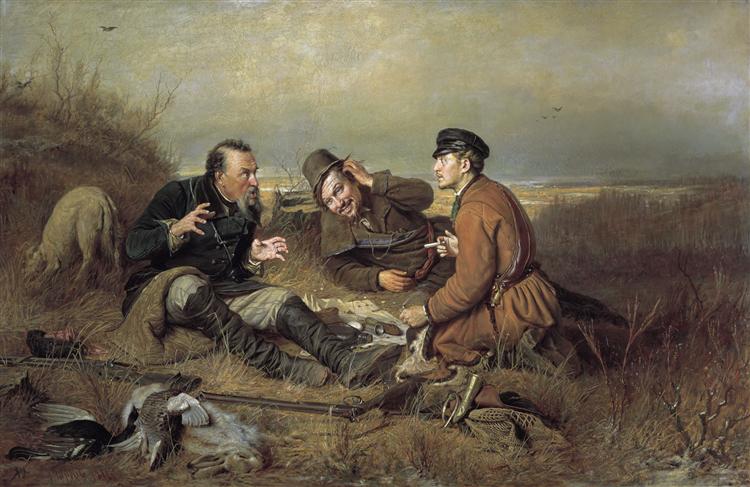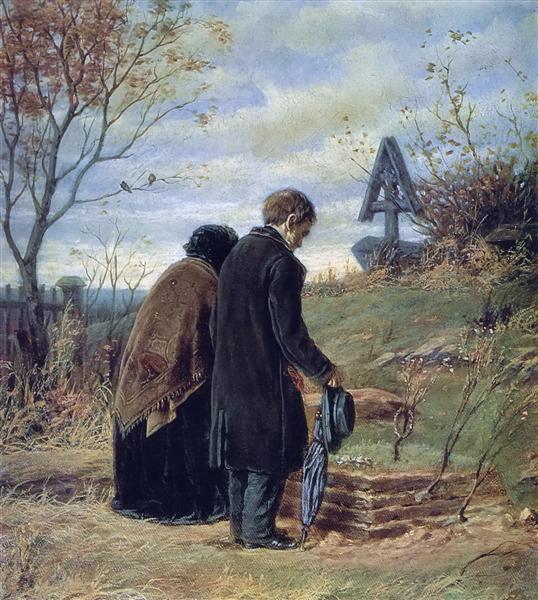The first work of Perov, painted after his return to Russia, was the painting “Seeing the Dead”. If the early works of Perov are an incriminating document with a detailed listing of evidence of existing evil, then the pathos of “Farewell to the Dead” is not an exposure of evil, but compassion for its victims. The mood of the picture is the silent, tearless grief of the poor, accustomed to misfortune.
It is known that Perov did not in any way connect the idea of the painting with Nekrasov’s poem “Frost – Red Nose”, although in the viewer’s consciousness “Seeing the Dead Man” is firmly fixed as an illustration to Nekrasov. Indeed, the picture could serve as the perfect screen saver for a poem. But in Nekrasov, where the funeral of a poor peasant is also described, there is still a funeral ritual, farewell, procession:
Killed, mournful couple. Mother and father walked in front. The guys with the deceased were both Sitting, not daring to sob, And, ruling the Savrask, at the coffin With the reins, their poor mother Chagall … Behind Daria’s neighbors, neighbors A thin crowd trailed …
Perov’s work is routine, the ordinariness of death and loneliness, almost incredible for a peasant’s life: there is not even a “not a dense crowd” of neighbors, there are no “wires” – they just bring the coffin. The only “seeing off” is the howling dog, it has the role to somehow “mourn” the deceased owner.
In previous works, Perov deliberately turned the faces of the heroes to the viewer, as if calling to read the traces of vices, deformities, and stupid meaninglessness of existence imprinted on them. In “The Dead Man’s Wires” he depicts the figure of the heroine from the back, hiding her face from the viewer, thus showing the delicacy of the artist, who understands that looking at the face of a grief-stricken person would be inappropriate, idle curiosity in this case. The former pictorial story turns into expressive silence. The landscape plays an important role. After thoroughly forgotten, episodic experiments in the first half of the 19th century in the images of winter, Perov was perhaps the first Russian artist of the middle of the century to make winter nature the artistic theme of his works. In “The Dead Man’s Wires” – the frozen earth, the gloomy slope, the cold distance. In “Troika” – an alarming wind and snowstorm, in “The Last Tavern at the Outpost” – winter twilight, drifting snow and icy sky.
“Seeing off the dead” was a significant success for Perov, but at the same time a really critical moment, that is, a turning point, emerged in critical realism. A descriptive genre with an accusatory tendency would be a step backward, a repetition of the past. The mere enumeration of the subjects that somehow occupied Perov in the second half of the 1860s betrays the desire to stay at the height of accusatory pathos, but at the same time demonstrates the “throwing” of the artist, who was previously so decisive in the choice of subjects and now does not seem to know what to start … Simultaneously with “The Dead Man’s Ways” was started (and soon thrown away) a large picture “The Monastic Meal”, plotting reminiscent of “Tea Party in Mytishchi”, but in a large-scale, epic version. At the same time, “Another at the pool” was written – the poor, in the winter cold and blizzard, standing in line for water.
Year of painting: 1865.
Dimensions of the painting: 43.5 x 57 cm.
Material: canvas.
Writing technique: oil.
Genre: genre painting.
Style: realism.
Gallery: State Tretyakov Gallery, Moscow, Russia.



